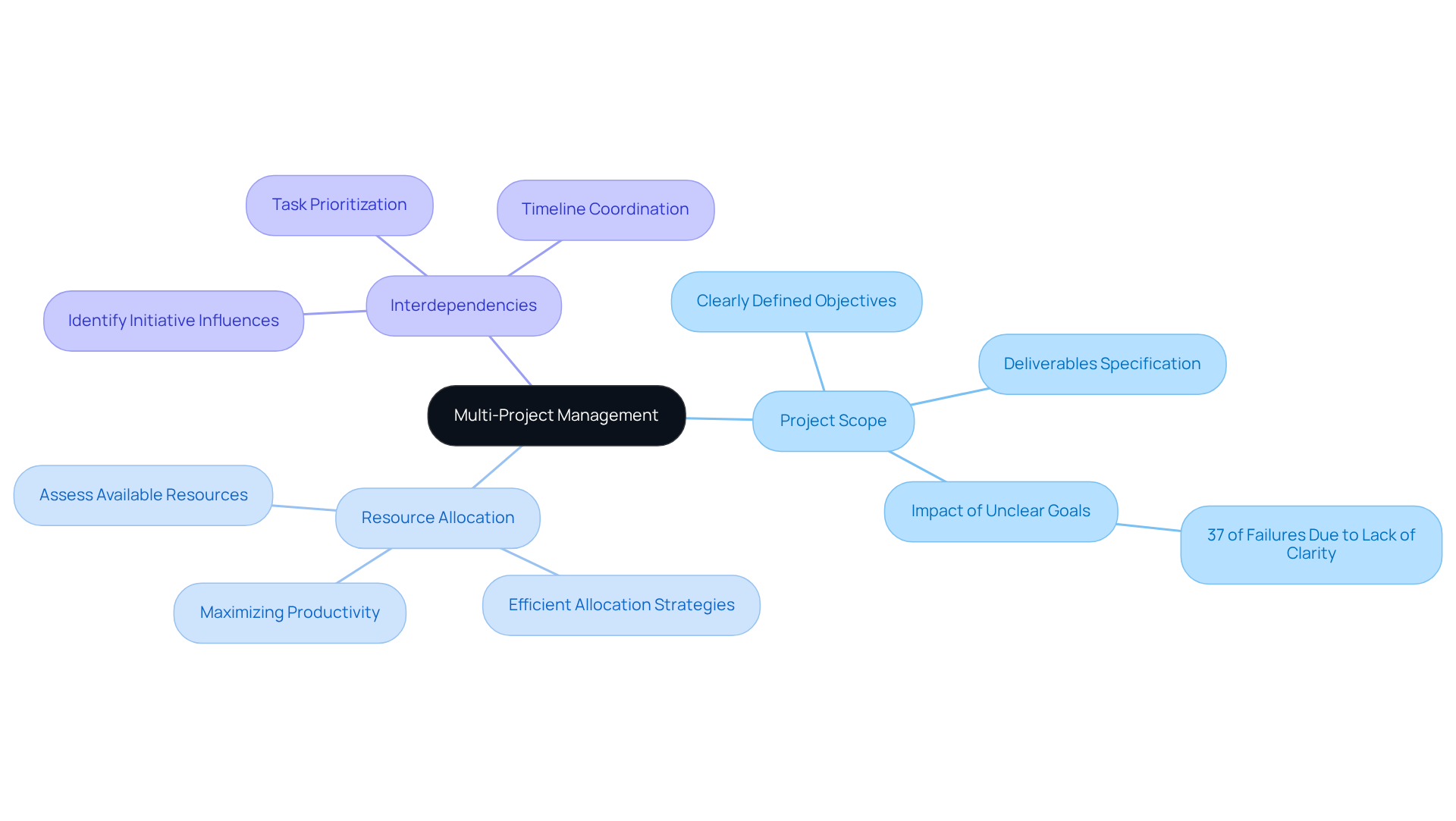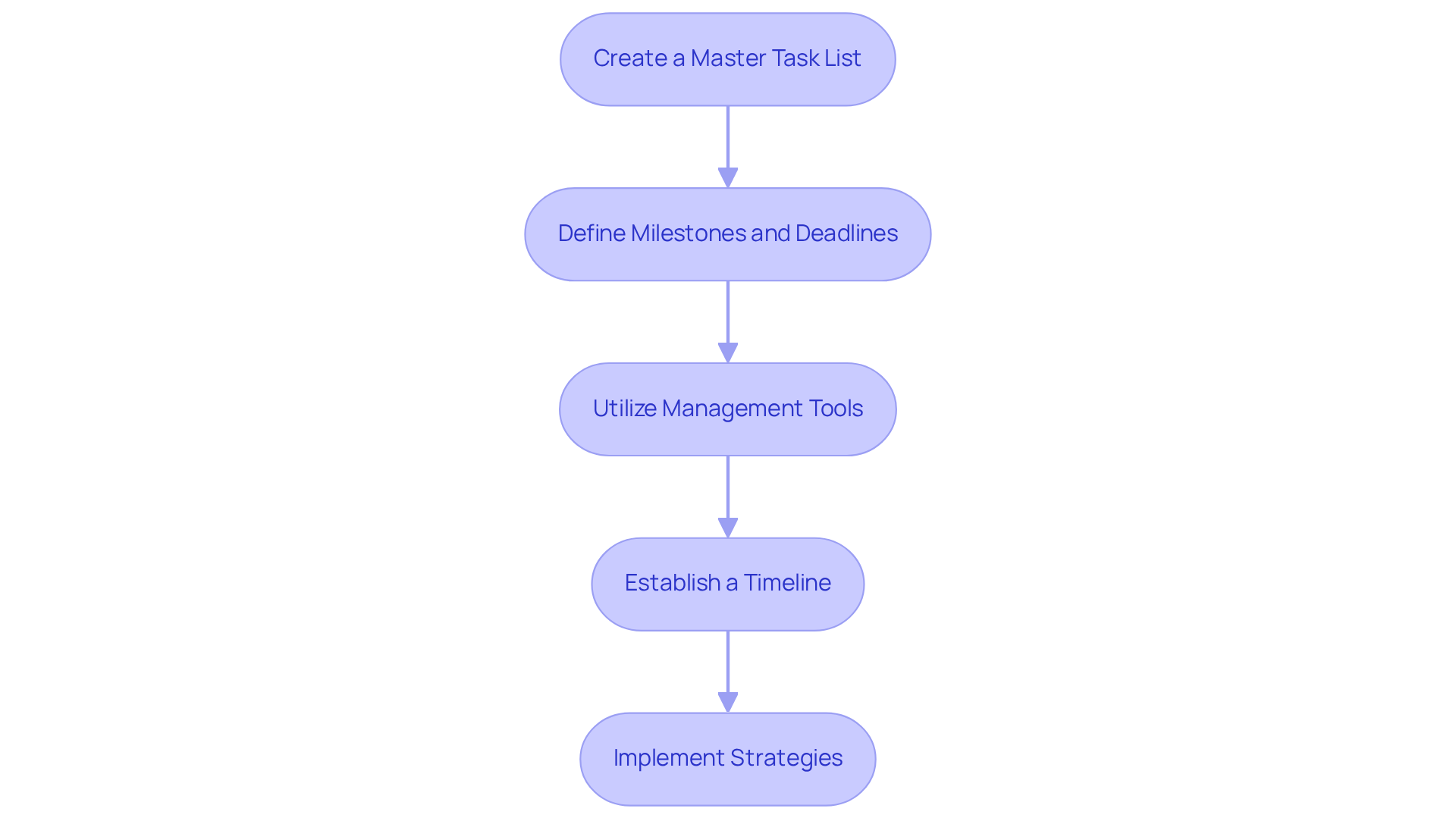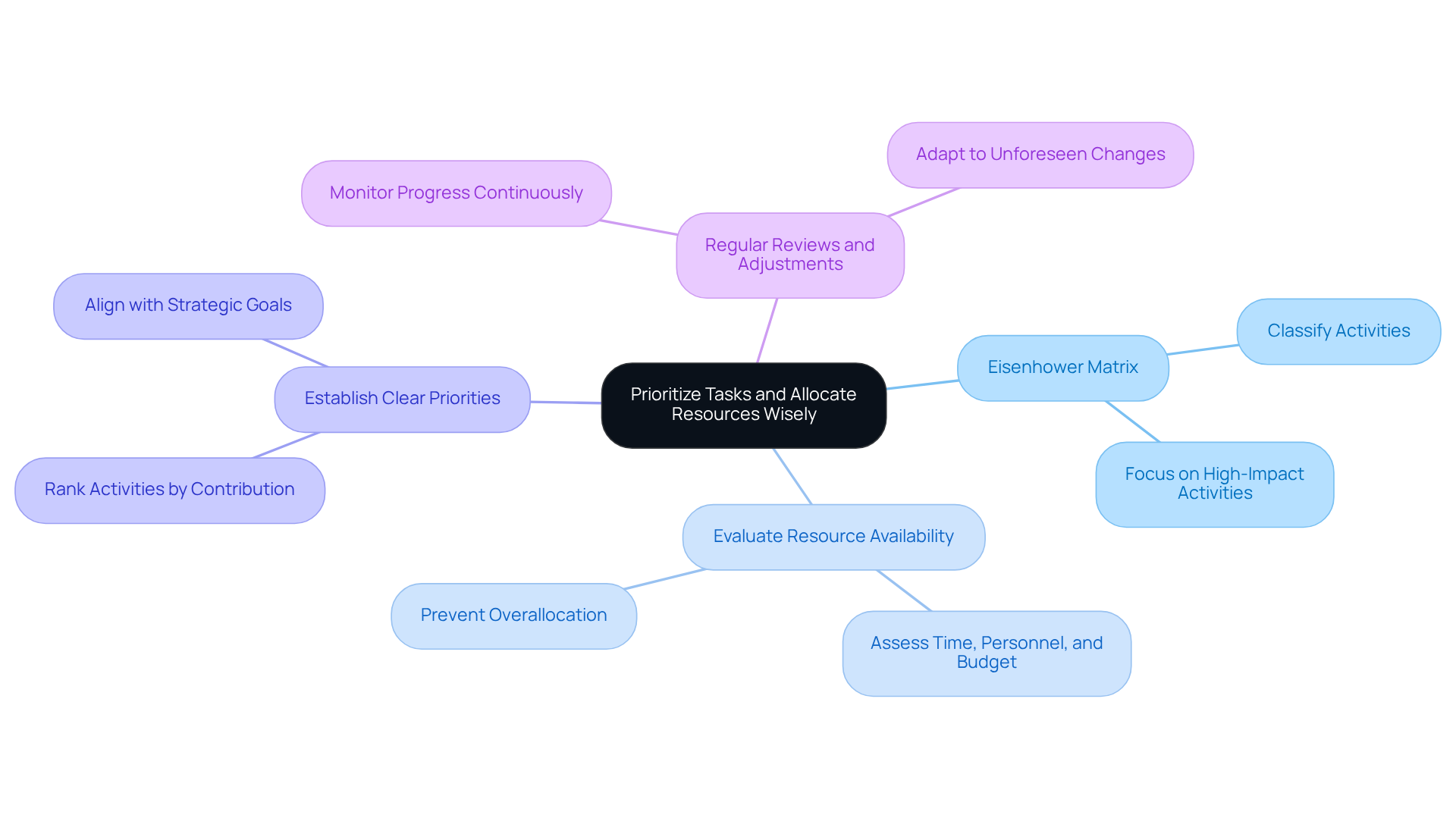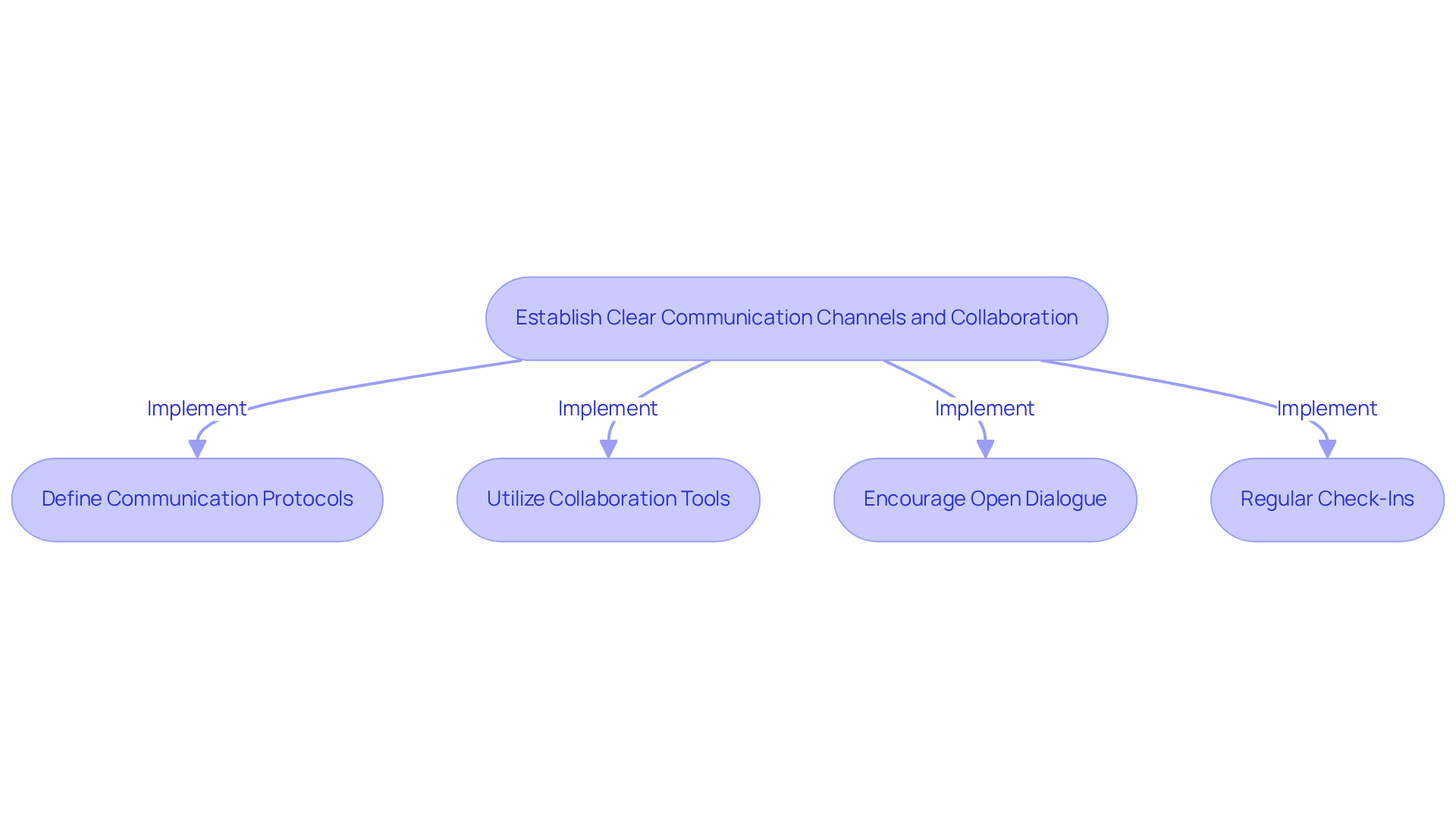Overview
This article delineates five essential steps for effectively managing multiple projects, with a strong emphasis on strategic organization, resource allocation, and communication. It underscores the critical importance of:
- Defining project scopes
- Utilizing management tools
- Fostering clear communication
By adopting this structured approach, readers can significantly enhance productivity and ensure successful project outcomes.
Introduction
Managing multiple projects simultaneously resembles juggling flaming torches—one misstep, and everything could come crashing down. With high stakes and an ever-increasing demand for efficiency, mastering the art of multi-project management is not merely a skill; it is a necessity for success. This article explores five essential steps that can transform chaos into order, offering strategies that enhance organization, communication, and productivity. But what occurs when the pressure mounts and priorities shift? How can one ensure that no project slips through the cracks amidst the whirlwind of tasks?
Understand the Basics of Multi-Project Management
Managing multiple projects requires a strategic approach that allows for the oversight of several tasks simultaneously, necessitating exceptional organization and planning. Begin by concentrating on these essential components:
-
Project Scope: Clearly define the objectives and deliverables for each project. A well-articulated initiative scope is crucial; studies reveal that 37% of strategic endeavor failures arise from a lack of clearly defined goals.
-
Resource Allocation: Assess the available resources—time, personnel, and budget—and determine how to allocate them efficiently across various initiatives. Organizations that adopt intelligent resource allocation strategies can maximize productivity and avert resource overload.
-
Interdependencies: Identify how initiatives influence one another. Understanding these interconnections allows for improved task prioritization and more efficient timeline coordination. This insight is vital, as uncoordinated execution can impede strategic progress, particularly in the fast-paced environments of startups.
By mastering these foundational elements, you can create a robust framework for managing multiple projects, which will ultimately enhance your team's efficiency and productivity.

Plan and Organize Your Projects Effectively
To effectively plan and organize your projects, consider these essential steps:
-
Create a Master Task List: Begin by compiling all assignments into a single document or tool. This consolidation provides a clear overview, facilitating better tracking and management of ongoing tasks. As Peter Drucker wisely noted, effective management is about doing things right.
-
Define Milestones and Deadlines: Next, break down each undertaking into phases, establishing specific milestones and deadlines to monitor progress. Jim Highsmith emphasizes that having a timeline for goals is crucial for success, enhancing accountability within the team.
-
Utilize Management Tools: Leverage tools like Casy to automate the creation and updates of responsibilities. This ensures that all information is centralized and easily accessible. Casy's integration with chat platforms such as Slack and Telegram further streamlines workflows, reducing the risk of miscommunication and administrative overhead.
-
Establish a Timeline: Create a timeline that clearly delineates when each phase of the initiative will occur. This facilitates improved resource distribution and scheduling. Warren Buffett highlights that planning for future benefits is essential; a well-structured timeline aids in prioritizing tasks efficiently.
By implementing these strategies, you can maintain organization and clarity while managing multiple projects, which ultimately enhances productivity and success. Consider this: studies show that startups typically excel at managing multiple projects, with an average of 3 to 5 projects being handled simultaneously. Thus, these strategies are even more critical for effective project management.

Prioritize Tasks and Allocate Resources Wisely
To prioritize tasks and allocate resources effectively, consider the following strategies:
- Utilize the Eisenhower Matrix: Classify activities into four quadrants based on urgency and significance. This method helps you focus on high-impact activities, ensuring that critical tasks are prioritized over less significant ones.
- Evaluate Resource Availability: Assess the resources at your disposal—time, personnel, and budget—for each assignment. Understanding what is available allows for informed allocation, preventing overallocation and ensuring that team members are not overwhelmed. Identifying resource availability is crucial for maintaining initiatives on schedule and preventing bottlenecks.
- Establish Clear Priorities: Rank activities within each initiative based on their contribution to overall objectives and deadlines. This structured approach ensures that the most crucial tasks receive attention first, aligning efforts with strategic goals. Approximately 70% of initiatives fall short of their goals, including timely delivery and budget adherence, highlighting the importance of effective prioritization.
- Implement Regular Reviews and Adjustments: Continuously monitor progress and be prepared to reallocate resources as demands evolve. Adaptability in resource allocation is crucial for responding to unforeseen changes and sustaining momentum. Tools like Birdview's resource allocation features can assist in visualizing resource availability and making necessary adjustments.
By adopting these strategies for managing multiple projects, you can enhance project management efficiency and ensure that resources are utilized optimally, keeping your projects on track.

Establish Clear Communication Channels and Collaboration
To establish clear communication channels and enhance collaboration, consider implementing the following strategies:
-
Define Communication Protocols: Clearly outline how and when members should communicate, such as through daily stand-ups or weekly updates. This clarity helps prevent misunderstandings and keeps everyone aligned.
-
Utilize Collaboration Tools: Leverage platforms like Slack or Casy to facilitate real-time communication and document sharing. Casy, specifically, automates the creation and updates of assignments, ensuring that all group members are informed and engaged without the burden of manual input.
-
Encourage Open Dialogue: Create an atmosphere where members feel at ease sharing updates, challenges, and feedback. As Nivedita Gopalakrishna observes, "These innovative platforms not only enhance communication and task management but also promote a culture of collaboration, innovation, and responsibility among groups."
-
Regular Check-Ins: Schedule consistent meetings to discuss progress, address concerns, and adjust plans as necessary. Regular check-ins can significantly enhance group productivity, as they offer chances for prompt feedback and adjustment. According to a McKinsey survey, effective communication can boost productivity by 20-25%, underscoring the importance of these interactions.
By prioritizing communication and utilizing effective collaboration tools like Casy, groups can enhance their cooperative efforts when managing multiple projects. This leads to improved results and a more engaged workforce.

Leverage Project Management Tools for Efficiency
To leverage project management tools for efficiency, follow these steps:
-
Choose the Right Tool: Selecting a task coordination tool that aligns with your team's needs is crucial. Casy, for instance, automates job creation and integrates effortlessly with communication platforms like Slack and Telegram, significantly reducing setup time and operational burden. With the demand for management specialists projected to reach 87.7 million by 2027, choosing the appropriate tool is more essential than ever.
-
Centralize Project Information: Utilize the tool to consolidate all project-related documents, timelines, and tasks in one centralized location. This method enhances accessibility and ensures that team members can easily locate the information they require, diminishing miscommunication and enhancing alignment. Poor planning accounts for 39% of project failures, underscoring the importance of effective information management.
-
Automate Routine Tasks: Harness automation features to minimize manual input and streamline processes. By automating everyday duties, such as updating documents and setting deadlines, your team can concentrate on high-value activities, significantly enhancing productivity. For example, Casy captures key information from conversations to create actionable tasks automatically. Statistics reveal that 80% of respondents spend half their time on rework, highlighting the time-saving benefits of automation.
-
Monitor Progress and Adjust: Regularly review dashboards to track progress and make necessary adjustments. This proactive approach enables teams to identify potential bottlenecks early and modify strategies to keep initiatives on schedule.
By effectively utilizing task coordination tools for managing multiple projects, you can enhance your team's productivity and ensure that initiatives are executed efficiently. Organizations employing project management software complete 61% of their projects on time, compared to just 41% for those that do not, emphasizing the critical role these tools play in achieving project success.

Conclusion
Effectively managing multiple projects is not just a necessity; it is a strategic advantage in today’s fast-paced environment. By implementing structured approaches to project scope definition, resource allocation, task prioritization, and clear communication, teams can significantly enhance productivity and drive successful outcomes across all initiatives. Establishing a solid framework for multi-project management empowers organizations to navigate complexities with confidence and agility.
This article outlines five essential steps to achieve this:
- Understanding the basics of multi-project management
- Planning and organizing projects effectively
- Prioritizing tasks and resources wisely
- Fostering clear communication and collaboration
- Leveraging project management tools for efficiency
Each step provides valuable insights into creating a cohesive strategy that maximizes team performance and minimizes risks associated with project overload and miscommunication.
In conclusion, adopting these best practices not only improves project execution but also cultivates a culture of collaboration and innovation within teams. Embracing effective multi-project management strategies can transform challenges into opportunities, ensuring that organizations remain competitive and capable of achieving their goals. As the demand for skilled project management continues to rise, investing in these principles is crucial for long-term success.
Frequently Asked Questions
What is the importance of project scope in multi-project management?
Clearly defining the project scope is crucial as it outlines the objectives and deliverables for each project. A well-articulated scope helps prevent failures, as studies show that 37% of strategic endeavor failures arise from a lack of clearly defined goals.
How can resource allocation impact project management?
Efficient resource allocation—considering time, personnel, and budget—maximizes productivity and prevents resource overload. Organizations that implement intelligent resource allocation strategies can better manage multiple projects.
Why is it important to understand interdependencies between projects?
Identifying how initiatives influence one another allows for improved task prioritization and efficient timeline coordination. Understanding these interconnections is vital to avoid uncoordinated execution, which can impede strategic progress.
What is the first step in planning and organizing multiple projects?
The first step is to create a master task list by compiling all assignments into a single document or tool. This provides a clear overview, facilitating better tracking and management of ongoing tasks.
How can milestones and deadlines contribute to project success?
Defining milestones and deadlines helps break down projects into phases, which enhances accountability and allows for monitoring progress. Having a timeline for goals is crucial for success.
What role do management tools play in multi-project management?
Management tools, such as Casy, help automate the creation and updates of responsibilities, ensuring that all information is centralized and easily accessible. This reduces the risk of miscommunication and administrative overhead.
Why is establishing a timeline important in project management?
A well-structured timeline delineates when each phase of the initiative will occur, facilitating improved resource distribution and scheduling. Planning for future benefits through a timeline aids in prioritizing tasks efficiently.
How many projects do startups typically manage simultaneously?
Startups typically excel at managing multiple projects, handling an average of 3 to 5 projects simultaneously. This highlights the importance of effective project management strategies.




